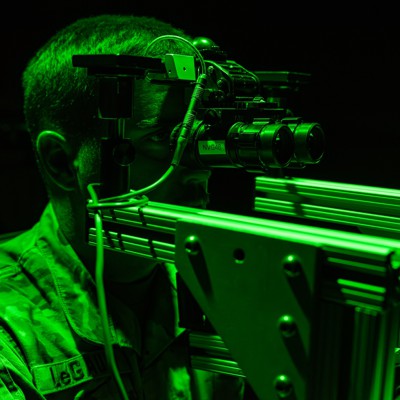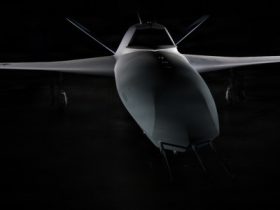As defense spending looks up in the U.S. and abroad, some defense firms are betting on “self-funded” prototypes. And while it’s not a new practice, there seems to be renewed emphasis with new-to-defense companies and some primes looking to preempt threats and programs of record.
Lockheed Martin CEO James Taiclet said the company is reaching the crescendo phase of a five-year shift in its research and development strategy that focuses more on corporate-level initiatives, such as the development of autonomous Black Hawks and space-based interceptors that could be used for the Trump administration’s proposed Golden Dome initiative.
“We are building prototypes, full-up operational prototypes. Not things in labs, not stuff on test stands. Things that will go into space or in the air or fly across a missile range. These are real devices that will work and that can be produced at scale. So the space-based interceptor is one we’ve been pursuing already. And that’s all I can say about that,” Taiclet said Tuesday during the company’s earnings call.
Taiclet said the company has submitted proposals for space-based interceptors, but the goal is to build prototypes for the government that work and can be produced en masse alongside new entrants in defense tech. And by 2028, Lockheed wants to put on a “real on-orbit space-based interceptor demonstration,” Taiclet said.
“[W]e are actually building prototype vehicles to demonstrate to the government, perhaps alongside with the new entrants, you could look at it that way, where we can show them a working vehicle that we can produce at scale that they can rely on. We’re pivoting our company’s approach to that,” he said. “We’re gonna keep answering RFPs and RFIs in the traditional way as well. But we are now in the business of self-funding prototypes at the corporate level which we can actually demonstrate real capability, leapfrogs to our customers.”
Over the past two years, Northrop Grumman has put more than $2 billion into its independent research and development, or IRAD, as a way to bring technology to the market faster, particularly as international sales grow, CEO Kathy Warden said during the company’s earnings call Tuesday.
“We are exploring creative ways to bring solutions to market faster and focusing on priority areas, such as the development and fielding of multi-function sensors, new and innovative ways to incorporate AI into our solutions, and developing and fielding new, smarter weapon systems that bring unmatched superiority on the battlefield…to name just a few,” Warden said. “Allied nations are prioritizing investments in air and missile defense, ground-based radars, airborne ISR, and other advanced weapon systems to enhance their ability to deter and defend against conflict. This growing demand presents substantial opportunities for our company, and…contributed to our international sales growing 20 percent year-to-date.”
The comments come as consensus builds around better integrating defense companies’ research and development efforts with the Pentagon’s, potentially filling funding gaps as threats and technologies rapidly evolve.
The Pentagon has increased its research and development funding in recent years. But it still struggles to field prototypes broadly, let alone convert them into programs of record—which can take about 12 years. And while companies often fund their own development of new technologies, it could be growing in popularity as new entrants look to prove themselves before a contract takes shape.
Next summer, Apex, an L.A.-based manufacturing startup that specializes in satellite buses, plans to launch a prototype for a platform that could be integral for space-based interceptors.
“In under a year, we are launching the host platform for space-based interceptors, called an orbital magazine, which will deploy multiple prototype missile interceptors in orbit,” Apex CEO Ian Cinnamon said in a statement announcing the initiative called Project Shadow. “Apex isn’t waiting for handouts or contracts; we are developing this orbital magazine technology on our own dime and moving incredibly fast.”
That “orbital magazine” is the “centerpiece” for space-based interceptors, Cinnamon told Defense One in a statement.
“The key pieces of these SBIs exist, but integrating them together is a technical challenge,” Cinnamon said. “Given the timeline required to ensure space-based interceptors are fielded soon enough to protect the U.S., waiting for a government contract isn’t feasible—using private money to accelerate the research and development is simply the right thing to do.”
But the risks are significant, he added, especially when it comes to the amount of money involved and the “short timeline” for the underlying technology to mature.
That drive to move quickly contrasts with how the major weapons programs often get their start, typically with Pentagon R&D funding for a prototype before becoming a pilot program. That is often where they get stuck, creating a mismatch between how much the Pentagon spends on research versus procurement, a Center for a New American Security report evaluating defense innovation spending points out.
“Traditionally, both initial steps are funded by the [Defense Department’s] research, development, test, and evaluation (RDTE) budget, although new defense companies are attempting to disrupt this process by building prototypes without formal requirements or DOD funds,” Carlton Haelig and Philip Sheers, CNAS fellow and research associate wrote in the report released this week.
As research and development costs grow, “overall procurement spending has remained stagnant, with many prototypes not yet entering full-scale production and fulfilling their procurement potential. In other words, the department is increasingly investing in research for sophisticated, leap-forward capabilities, but many such programs, from the Constellation-class frigate to the upgraded F-35, have fallen into a developmental cul-de-sac, failing to transition into procurement in large enough numbers to make a difference for U.S. warfighters,” the report states.
To break that cycle, some companies are working with the military, taking technologies directly to the operators who use them. It’s a tactic Textron is leaning into with its unmanned offerings despite the Army canceling key programs, including Future Tactical Unmanned Aerial Systems.
“With that program not happening, at least in the way it was envisioned—that was a hit. But look, the reality is these brigades need ISR,” Textron CEO Scott Donnelly said during Thursday’s earnings call.
Donnelly said the plan is to “take these systems directly to the brigades, and they’ll drive that demand” per directions from Army Chief of Staff Gen. Randy George.
“So that’s what we’re doing right now. And that’s why I say, while FTUAS didn’t happen as a program, I do think that we will see a number of opportunities as we go out and sell that technology directly out to the warfighter,” he said, noting international interest and potential opportunities with U.S. Customs and Border Patrol.
“There’s a lot of interest in a lot of the technology we’ve developed around FTUAS, and so that stuff will play out.”
Read the full article here








Leave a Reply